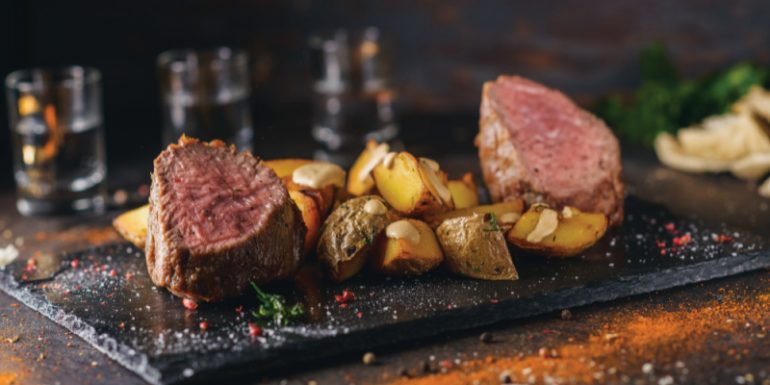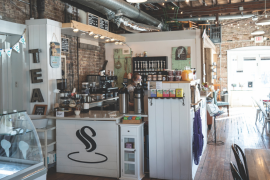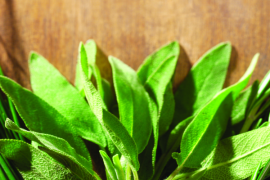By Bill Turner
You’ve probably heard of the cooking technique called sous vide. It’s been used in restaurants for years, but it’s now catching on rapidly at home.
“Sous vide” is French for “under vacuum,” and it refers to vacuum-sealing food in plastic bags and then cooking it in a temperature-controlled water bath. Wholesale food distributors commonly deliver their products to restaurants in vacuum-sealed packages to ensure freshness. Cooking them with the sous vide method gives you consistent results.
In a nutshell, here’s how you can cook this way at home. First, go online to Amazon and buy a sous vide immersion cooker — you’ll spend about $90, but it’s well worth it. You can set this device to heat water to a specific temperature, with most models being accurate within 0.5 degrees.
Next, clamp the sous vide to your largest pot, fill the pot with water and set the temperature to 129 F. Take a sirloin strip steak and seal it in a quart zip-lock bag and throw it in the pot for at least 1 hour, 30 minutes or leave it in all day. Time doesn’t matter because that steak will never cook beyond 129 F, which is perfect if you like your steak cooked medium. If you want rare, set the immersion cooker to 125 F; for well-done, it’s 156 F.
When the steak is done, heat your grill as hot as you can. Remove the steak from the plastic bag, dry with a paper towel and add salt, pepper, garlic or whatever strikes your fancy. Now, throw it on the hot grill for one minute each side, serve and listen to everyone laud your work. Tell them that you cooked the steak “sous vide” and they will think that you are really cool.
All of the major steakhouses use this method. They usually have three or four sous vide setups, each with a different temperature.
If you have been paying attention so far, you are probably scratching your head wondering whether you should spring for this crazy new gadget. Stop thinking and just do it! You won’t regret it and you and your family will have a ball. With any of the devices, you will get an online source of recipes, temperatures and cooking times, or just Google a sous vide recipe for anything that you can think of. Check out lakegenevacountrymeats.com for a selection of beef recipes.
SOUS VIDE MEATS AND SEAFOOD
Sous vide works best on meats and seafood, all of which can be finished on your gas or charcoal grill, making it perfect for summertime. Here are some of my favorite entrees:
• Pork tenderloin: This is one of my favorite cuts of pork: it is inexpensive, lean and very tasty. However, it often turns out dry because we are always worried about undercooking pork and getting trichinosis, which is extremely rare. Sous vide eliminates all risk. Cook the tenderloin with your sous vide for at least 1 hour, 30 minutes at 140 F and it will be perfect. My favorite way to finish the tenderloin is to coat it with hoisin sauce and throw it on a hot grill for 2 minutes each side. Cut the loin in medallions, add a little more hoisin sauce and the crowd will go wild.
• Beef brisket: In sous vide, the cooking time varies depending on the type of meat. While a pork tenderloin takes only 1 hour, 30 minutes, a brisket takes 48 hours at 135 F! While that may seem crazy, it simply means that you have to plan ahead in order to have the best brisket you have ever tasted. I like to thinly slice it and serve it with a good barbecue sauce. You can also add a dry rub and smoke it for 1 hour at the end.
• Strip sirloin or filet mignon: Sirloin is the obvious choice for sous vide because of the degree of temperature control you can achieve. As mentioned previously, a setting of 129 F for 1 hour, 30 minutes cooks the meat to a perfect medium; a setting of 125 F will give you rare and 156 F produces a steak that’s well- done. The only confusion is when you are having a party and everyone wants their steak cooked differently. Obviously, we are not going to buy two or three sous vide cookers to solve the problem. You have two options: First, cook the steaks to 125 F for rare and then cook them longer on the grill for medium and well-done. Second, and my preferred technique — just cook them at 129 F for medium and don’t give anyone a choice.
• Calamari, scallops and octopus: These are the most difficult seafood dishes to make since they are so easy to overcook, turning rubbery and tough quickly. I once complimented a chef on an octopus appetizer and he told me the secret was sous vide. Octopus is very dense and requires 5 hours at 175 F in a sous vide cooker. Calamari, a little less dense, requires 2 hours at 138 F. Scallops, the most delicate of all, only requires 30 minutes at 123 F. Finish any one of these treasures for 1 minute in a hot cast iron pan with olive oil or butter and chopped garlic, stirring continually.
SOUS VIDE VEGETABLES
Although meats are the usual choice for sous vide cooking, vegetables are also a great choice and produce far better results than steaming. How often have you ended up with mushy broccoli or undercooked potatoes? That never happens with sous vide. Here are some of my favorite recipes:
• Potatoes: Put red or Yukon gold potatoes in a quart or gallon zip-lock bag and cook for 1 hour at 190 F. Remove, smash and add butter, salt and pepper. You will be amazed at how perfect they are.
• Broccoli: I can’t stand mushy broccoli and that is often the result when steaming this vegetable. Use the sous vide instead: 20 minutes at 194 F. Remove and add olive oil, lemon juice, chopped garlic, salt and pepper, and you have a real treat.
TREATS IN MASON JARS
Another whole world of sous vide opens up when you bring 4 oz. Mason jars into the picture. Go buy a dozen at the hardware store now. Here are two of my favorite recipes to get you started:
• Cheesecake: Holy cow, this one is so easy. Set the sous vide to 175 F. Combine 16 oz. cream cheese, 1/2 cup sugar, 1⁄4 cup heavy cream, 1 tsp. vanilla and 2 eggs. Use your electric hand mixer to beat into a rich cream. Add 1/2 cup berries while you are mixing if you wish. (Strawberry cheesecake is especially good.) Fill 8 Mason jars, not too full, and just barely tighten the lid. Use tongs to put them in the sous vide water bath and cook for 2 hours. Take out, cool and put into the refrigerator for another 2 hours to set. This is a great dinner party dessert or late-night snack.
• Egg bites: You may have noticed these at Starbucks. They are easy to make at home and provide the perfect quick breakfast for adults and kids. Here is an easy recipe to start, but you can experiment endlessly. Sauté 1 chopped red pepper with 1 pound of breakfast sausage. Allow to cool for 10 minutes while you beat 12 eggs in a mixing bowl with salt and pepper. Add the sausage and red pepper, mix well and fill 12, 4-oz. Mason jars. Cook in the sous vide for a minimum of 1 hour at 172 F. Remove and allow to cool. Serve immediately or store in the refrigerator. When ready to eat, remove the lid and pop into the microwave for one minute.
Try sous vide – you will love it.





